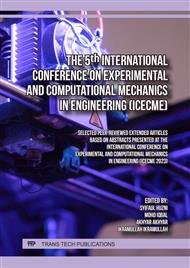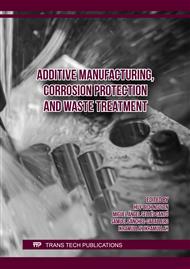[1]
A. Ashori, "Wood–plastic composites as promising green-composites for automotive industries!," Bioresource Technology, vol. 99, no. 11, p.4661–4667, 2008.
DOI: 10.1016/j.biortech.2007.09.043
Google Scholar
[2]
P. Joshi et al., "Cassava starch-derived aerogels as biodegradable packaging materials," Materials Chemistry and Physics, vol. 296, p.127282, 2023, doi: https://doi.org/10.1016/j.matchemphys. 2022.127282.
DOI: 10.1016/j.matchemphys.2022.127282
Google Scholar
[3]
S. P. Bangar, W. S. Whiteside, P. Kajla, and M. Tavassoli, "Value addition of rice straw cellulose fibers as a reinforcer in packaging applications," International Journal of Biological Macromolecules, vol. 243, p.125320, 2023.
DOI: 10.1016/j.ijbiomac.2023.125320
Google Scholar
[4]
Inaplas, "EU rules out tax on plastic products to reduce waste," 2017.
Google Scholar
[5]
Y. A. Yudanto and I. Pudjihastuti, "Characterization of physical and mechanical properties of Biodegradable foam from maizena flour and paper waste for Sustainable packaging material," International Journal of Engineering Applied Sciences and Technology, vol. 5, no. 8, p.1–8, 2020.
DOI: 10.33564/ijeast.2020.v05i08.001
Google Scholar
[6]
P. Coniwanti, R. Mu'in, H. W. Saputra, M. A. RA, and R. Robinsyah, "Pengaruh konsentrasi naoh serta rasio serat daun nanas dan ampas tebu pada pembuatan biofoam," Jurnal Teknik Kimia, vol. 24, no. 1, p.1–7, 2018.
DOI: 10.36706/jtk.v24i1.411
Google Scholar
[7]
F. L. Berutu, R. Dewi, M. Muhammad, Z. Ginting, and N. ZA, "Biofoam Berbahan Pati Sagu (Metroxylon RUMPHII M) Dengan Bahan Pengisi (Filler) Serat Batang Pisang Dan Kulit Pisang Menggunakan Metode Thermopressing," Chemical Engineering Journal Storage (CEJS), vol. 2, no. 1, p.61, 2022.
DOI: 10.29103/cejs.v2i1.6420
Google Scholar
[8]
Y. Ruscahyani, S. Oktorina, and A. Hakim, "Pemanfaatan Kulit Jagung Sebagai Bahan Pembuatan Biodegradable Foam," Jurnal Teknologi Technoscientia, vol. 14, no. 1, p.25–30, 2021.
DOI: 10.34151/technoscientia.v14i1.3295
Google Scholar
[9]
R. Marlina, S. S. Kusumah, Y. Sumantri, A. Syarbini, A. A. Cahyaningtyas, and I. Ismadi, "Karakterisasi Komposit Biodegradable Foam Dari Limbah Serat Kertas Dan Kulit Jeruk Untuk Aplikasi Kemasan Pangan," Jurnal Kimia dan Kemasan, vol. 43, no. 1, p.1, 2021.
DOI: 10.24817/jkk.v43i1.6765
Google Scholar
[10]
A. Sarkar and G. Praveen, "Utilization of Waste Biomass into Useful Forms of Energy," p.117–132, 2017.
DOI: 10.1007/978-3-319-47257-7_12
Google Scholar
[11]
S. R. Naqvi, I. Ali, S. Nasir, S. Ali Ammar Taqvi, A. E. Atabani, and W. H. Chen, "Assessment of agro-industrial residues for bioenergy potential by investigating thermo-kinetic behavior in a slow pyrolysis process," Fuel, vol. 278, no. May, p.118259, 2020.
DOI: 10.1016/j.fuel.2020.118259
Google Scholar
[12]
M. Zulqar Nain and S. Kasilingam, "Influence of rice husk ash and bagasse ash on durability of concrete," Materials Today: Proceedings, 2023, doi: https://doi.org/10.1016/j.matpr. 2023.06.464.
DOI: 10.1016/j.matpr.2023.06.464
Google Scholar
[13]
A. S. Ratna, A. Ghosh, and S. Mukhopadhyay, "Advances and prospects of corn husk as a sustainable material in composites and other technical applications," Journal of Cleaner Production, vol. 371, p.133563, 2022.
DOI: 10.1016/j.jclepro.2022.133563
Google Scholar
[14]
S. Wang, H. Li, S. Zou, and G. Zhang, "Experimental research on a feasible rice husk/geopolymer foam building insulation material," Energy and Buildings, vol. 226, p.110358, 2020.
DOI: 10.1016/j.enbuild.2020.110358
Google Scholar
[15]
W. Sanhawong, P. Banhalee, S. Boonsang, and S. Kaewpirom, "Effect of concentrated natural rubber latex on the properties and degradation behavior of cotton-fiber-reinforced cassava starch biofoam," Industrial Crops and Products, vol. 108, p.756–766, 2017.
DOI: 10.1016/j.indcrop.2017.07.046
Google Scholar
[16]
R. Radam, M. A. Soendjoto, and H. A. A. Rezekiah, "Pengaruh kerapatan terhadap pengembangan tebal dan penyerapan air papan partikel dari sabut kulit buah nipah," in Prosiding Seminar Nasional Teknologi Hasil Hutan 2018, Forestry Faculty, Lambung Mangkurat University, 2018, p.169–177.
Google Scholar
[17]
S. S. Gani and H. Kusumayanti, "The optimization of additional of glycerol on the biodegradable foam from corn husk," Journal of Vocational Studies on Applied Research, vol. 3, no. 3, p.73–81, 2022.
DOI: 10.14710/jvsar.v3i3.14303
Google Scholar
[18]
D. T. Hallinan et al., "Effect of Polystyrene Synthesis Method on Water Sorption and Glass Transition," Membranes, vol. 12, no. 11, 2022.
DOI: 10.3390/membranes12111059
Google Scholar



